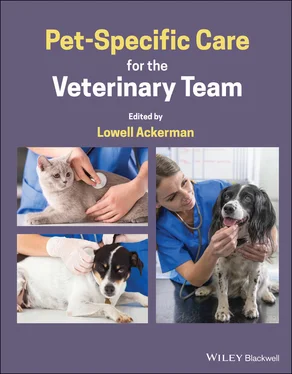5 Munkevics, M., Munkevica, S. (2017). Why does placebo work on dogs and cats? http://pet‐happy.com/why‐does‐placebo‐work‐on‐pets
6 Sifferlin, A. (2018). Placebo's new power. Time Magazine 3/10: 65–69.
2.14 Benefits of the Human–Animal Bond
Jacqui Ley, BVSc (Hons), PhD, DECAWBM, FANZCVS (Veterinary Behaviour)
Melbourne Veterinary Specialist Centre, Glen Waverley, Victoria, Australia
 BASICS
BASICS
2.14.1 Summary
The human–animal bond (HAB) is the glue that keeps companion animals in families. The strength of the HAB affects if a pet is obtained, its management and healthcare and if it is retained and valued by its family. Many benefits arise from the HAB such as improved human physical and psychological health. Veterinary clinics and the wider community benefit from strong HABs. Understanding how the bond is expressed and how it affects owner decisions can aid veterinary practices to provide the kind of care they want while avoiding compassion fatigue.
Attachment:The enduring emotional bond between individuals. It is characterized by behaviors such as seeking proximity to the individual and being attentive to their needs.
Compassion Fatigue:Also known as secondary traumatic stress disorder, this is the gradual loss of compassion by people who work with individuals who are ill, suffering, or victims of trauma. This includes veterinary staff working with worried clients with sick or injured animals. Signs include indifference, disengagement, withdrawal from patients and co‐workers, and even physical signs relating to chronic stress.
Human–Animal Bond (HAB): A measurable psychological construct encompassing the feelings of attachment between an owner and a pet. It has been well described from the human perspective but is not well understood from the animal's view.
Problem Behavior:Behavior exhibited by the animal that is considered undesirable. The behavior may be normal for the species or it may be due to a mental health disorder.
 MAIN CONCEPTS
MAIN CONCEPTS
It can be difficult to understand why one owner will do everything for their pet and another will only do the bare minimum. The cause may be differences in the HAB. The HAB describes the connection people feel toward animals for which they care. The expression of the HAB is affected by many things but two factors important to veterinary practice, because they affect owner healthcare decisions, are owner attachment and owner commitment to the pet.
The HAB may affect owner decisions as to the choice of pet and where it is acquired, how the pet lives with them and owner lifestyle such as where they live, work, and take holidays. The bond is affected by the owner's experience of pet ownership, expectations of this pet and perceived social expression and norms, among other factors.
The human experience of the HAB is well described. Owners can be located along a continuum from highly attached (the pet is considered a valued family member) through to less attached (the pet is a thing). For example, owner attachment levels may affect an owner's willingness to accept the financial costs of treatment for a pet. Highly attached owners may also have difficulty accepting that their pet is unwell [1]. Some highly attached owners may also struggle emotionally when their pet is given a terminal diagnosis or when it dies.
The HAB is also affected by the animal. The bond is fragile and easily damaged and is especially vulnerable when owners have high expectations of a pet. Relinquishment occurs most commonly due to problem behavior by the animal. Annoying behaviors such as being boisterous or destructive and dangerous behaviors such as aggression are frequently given as reasons for surrendering dogs.
How fracture of the bond affects the animal is not well understood but it may have far‐reaching effects for some. Humans report that the decision to relinquish a pet causes significant distress [2].
Communities benefit when owners have strong bonds with their pets. Interacting with pets has documented benefits for people – for their health and their psychological welfare. Strong bonds result in fewer animals being relinquished to shelters or abandoned. The HAB can also have negative effects for communities. Attached and committed owners are less likely to evacuate during natural disasters (see 2.17Emergency Preparedness). If unable to take their pets with them, people in abusive relationships may delay leaving and seeking help. The large numbers of pets relinquished to animal shelters every year due to fracture of the HAB create community problems in caring for, rehoming or euthanizing unwanted pets. Noise from dogs and cats, feces left in public places, aggression by dogs to people and other animals, and cruelty and neglect of animals are all community issues that stem from the HAB.
The challenge for veterinary clinics is to encourage and support their clients’ bonds with their pets, while accepting all levels and types of bonds. When veterinary clinic staff are aware of the HAB in general and, more specifically, the nature of their personal bond with their pets, it can help them support owners and accept different approaches to pet care. For example, many staff struggle when owners elect not to treat very treatable conditions because it clashes with their own beliefs about how animals should be treated.
Supporting client bonds with their pets must be authentic to be worthwhile [1]. How each clinic does this will be different due to the nature of their community and clinic. For some clinics, pet birthday card mailouts work while others find displaying professional photographs of staff with their pets demonstrates the HAB best for them. Genuine interest in the client's pet and their concerns is essential.
Clinics can encourage strong HABs in several ways. Managing owner expectations of pets is very important. This may be done by posting information about raising a puppy or a kitten for the first 12 months on the clinic website or blog. The value of pets to humans and communities can be written about in newsletters. Technicians and nurses can offer “Preparing for a new pet” consultations for clients before they purchase a pet. Well‐run puppy and kitten classes are also great assets for supporting the HAB. Clients should be asked about problems with their pet's behavior at each consultation.
Recognizing an owner's attachment level also helps when presenting healthcare information. Highly attached owners may respond to information that emphasizes quality of life and pain relief outcomes while owners with more utilitarian attachment will respond to information that considers the costs of treatment versus benefits and prognosis.
The end of a pet's life can also be a celebration of the bond between the owner and pets (see 6.20Quality of Life and End of Life Issues). Palliative care services can preserve animal welfare while providing time for owners to prepare for the loss of their pet (some owners find it difficult to return to the place their pet was euthanized). Some owners change vets. Offering clients home euthanasia or partnering with a veterinary palliative care and euthanasia service can help support clients (see 9.18 Hospice and Palliative Care). Offering high‐quality cremation and burial services is another way clinics can help owners remember pets and support the HAB.
Читать дальше

 BASICS
BASICS MAIN CONCEPTS
MAIN CONCEPTS










